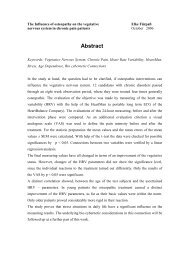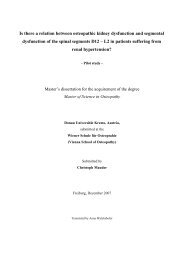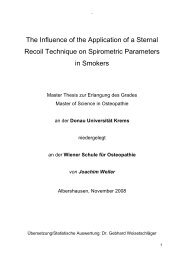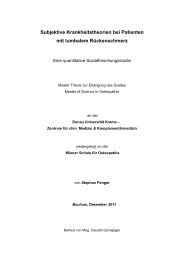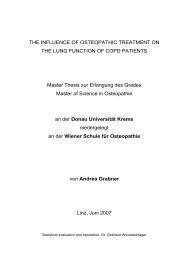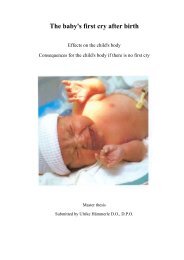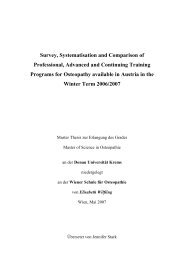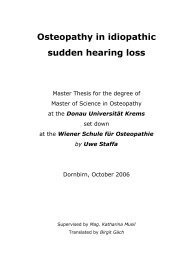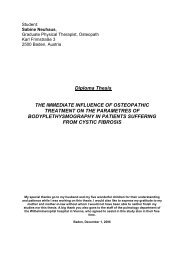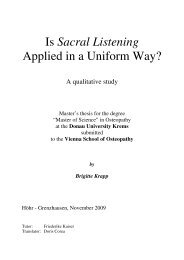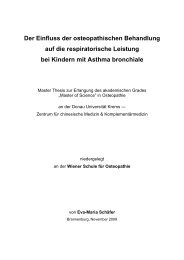Can back pain caused by symptom-giving sacroiliac joint relaxation ...
Can back pain caused by symptom-giving sacroiliac joint relaxation ...
Can back pain caused by symptom-giving sacroiliac joint relaxation ...
You also want an ePaper? Increase the reach of your titles
YUMPU automatically turns print PDFs into web optimized ePapers that Google loves.
3.2.3. Therapy<br />
In each of the three therapy sessions the patient handed in seven questionnaires<br />
from the previous week.<br />
In this study the osteopathic therapy served as a black box and was adapted<br />
completely to the individual needs of the patients. My choice of technique was based<br />
on strict consideration of the previously created “osteopathic diagnostic findings“. The<br />
therapy was conducted according to the doctrine of the Vienna School of<br />
Osteopathy. I considered it to be very important to see the pregnant patient as an<br />
entity and thus I took into account that causes may originate from all parts of the<br />
body.<br />
Contents of the therapy:<br />
o Tips and advice for daily life<br />
o Mobilisation of the iliopsoas muscle, the thoracolumbar fascia, the obturator<br />
membrane, the adductor muscles of the hip, the coccyx etc.<br />
o Mobilisation and thrust techniques in the thoracic spine and thoracolumbar<br />
junction, upper and lower ribs, and partly also in the cervical spine<br />
o Fascial techniques in the areas of the iliotibial tract, thoracolumbar fascia,<br />
thoracic spine, obturator membrane etc.<br />
o Mobilisation in the visceral area: very frequently at the diaphragm including the<br />
crura, at the stomach, liver, kidneys and bladder, ligaments of the uterus etc.<br />
o Intraosseous techniques at the sacrum, coccyx, occiput, temporal bone,<br />
sternum, …<br />
o Craniosacral techniques: SSB techniques, CSF techniques, techniques on the<br />
reciprocal tension membrane, synchronisation of the sacrum and the occiput<br />
o Compensatory movements and exercises for stabilisation of the pelvis<br />
3.2.4. Post diagnosis<br />
The patient handed in the last seven questionnaires.<br />
The <strong>pain</strong>ful SIJ instability was checked a second time <strong>by</strong> means of the test sheet and<br />
the additional tests were made for evaluation.<br />
Master’s Thesis Wolfgang Aspalter 37



